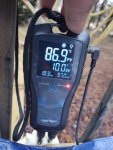My wife and I read a while back about people using stock tanks to build a hot tub. We mentioned building our own kind of jokingly.
Well, about a month ago my wife says, "When you gonna build my hot tub?" (Me) "You serious?" "Yes!"
SAY NO MORE!
I spent a little time reading through some builds and came up with my own plan.
I'm using an Intex 1500 gph filter pump, intex plunger valves and inlet/outlet fittings, and a 110v heater found on Amazon.
Most of the builds I found insulate them but (IMO) very poorly. HeyWanderer has a blog and they do some great stuff. They built one and used this same heater and say it works great. However, their insulation was nothing more than a layer of reflectix and a wool blanket. Reflectix offers almost no insulating value without an air space, so it's really mostly just the insulation value of a wool blanket. They also cover it with a tarp.
I hope to have ours insulated a little better so perhaps I don't have to run the heater as much. I wrapped mine with 6 layers of carpet padding, which I happened to have in the attic after pulling out carpet up and putting LVP down. This was the best idea I could come up with to insulate a round tank. Other than several inches of spray foam, which is EXPENSIVE. Best I can find by research is an R value of 0.5 to 1 on average for a layer of carpet padding. This leaves me nowhere near the R value of a "real" hot tub, but I do believe it to be better than most of the DIY hot tubs I've found.
Once I built the deck around it, I air sealed it with foam underlayment, which I also happened to just have lying around in the attic. I used foam insulation on the side walls as much as possible also. I had a goal of putting foam insulation all around top and bottom, but that was just going to turn out to be too expensive.
I work for a lumber company, and almost all of my lumber for the deck was free culled lumber that was destined for the dumpster. Using cull stuff made some of the framing interesting but I got it. The decking wasn't free but it was an old weathered pack we couldn't sell to Lowe's so I got a steep discount. Break the pack open and most of the pieces on the interior are good.
I have R 5 foam insulation covering it right now, but it's temporary. I want to build a cover out of two layers of R10 2" foam board and plywood or wood slats. Maybe a bubble cover on the water surface as well. I think that I might fill the cabinet with blow in attic insulation or something of the sort later if it doesn't hold heat as well as I'd like. I rebuilt and restored a fiberglass boat a few years back and had to pour expanding floatation foam below the deck. That would be perfect for this application, but it's also very expensive. It would make replacing this tank in the future extremely difficult also.
I got it all hooked up and filled with water yesterday. So far it seems leak free, and I'm gaining about 1.5 degrees per hour. It's controlled by a digital temperature controller set to 100F, with a 3° differential set + and -. The heater has a flow switch and kicks in when the pump comes on. The pump is connected to the digital temperature controller, it will come on when the water temp is 97, and kick off once the temp reaches 103. The thermostat on the heater is set to 104.
Once I am certain it's all working like I want it to, and it's all leak free, I'll button the sides up with some access doors.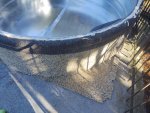
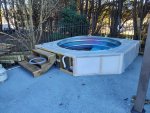
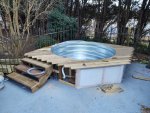
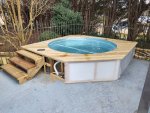
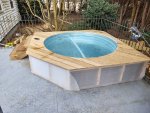
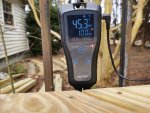
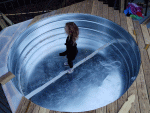
Well, about a month ago my wife says, "When you gonna build my hot tub?" (Me) "You serious?" "Yes!"
SAY NO MORE!
I spent a little time reading through some builds and came up with my own plan.
I'm using an Intex 1500 gph filter pump, intex plunger valves and inlet/outlet fittings, and a 110v heater found on Amazon.
Most of the builds I found insulate them but (IMO) very poorly. HeyWanderer has a blog and they do some great stuff. They built one and used this same heater and say it works great. However, their insulation was nothing more than a layer of reflectix and a wool blanket. Reflectix offers almost no insulating value without an air space, so it's really mostly just the insulation value of a wool blanket. They also cover it with a tarp.
I hope to have ours insulated a little better so perhaps I don't have to run the heater as much. I wrapped mine with 6 layers of carpet padding, which I happened to have in the attic after pulling out carpet up and putting LVP down. This was the best idea I could come up with to insulate a round tank. Other than several inches of spray foam, which is EXPENSIVE. Best I can find by research is an R value of 0.5 to 1 on average for a layer of carpet padding. This leaves me nowhere near the R value of a "real" hot tub, but I do believe it to be better than most of the DIY hot tubs I've found.
Once I built the deck around it, I air sealed it with foam underlayment, which I also happened to just have lying around in the attic. I used foam insulation on the side walls as much as possible also. I had a goal of putting foam insulation all around top and bottom, but that was just going to turn out to be too expensive.
I work for a lumber company, and almost all of my lumber for the deck was free culled lumber that was destined for the dumpster. Using cull stuff made some of the framing interesting but I got it. The decking wasn't free but it was an old weathered pack we couldn't sell to Lowe's so I got a steep discount. Break the pack open and most of the pieces on the interior are good.
I have R 5 foam insulation covering it right now, but it's temporary. I want to build a cover out of two layers of R10 2" foam board and plywood or wood slats. Maybe a bubble cover on the water surface as well. I think that I might fill the cabinet with blow in attic insulation or something of the sort later if it doesn't hold heat as well as I'd like. I rebuilt and restored a fiberglass boat a few years back and had to pour expanding floatation foam below the deck. That would be perfect for this application, but it's also very expensive. It would make replacing this tank in the future extremely difficult also.
I got it all hooked up and filled with water yesterday. So far it seems leak free, and I'm gaining about 1.5 degrees per hour. It's controlled by a digital temperature controller set to 100F, with a 3° differential set + and -. The heater has a flow switch and kicks in when the pump comes on. The pump is connected to the digital temperature controller, it will come on when the water temp is 97, and kick off once the temp reaches 103. The thermostat on the heater is set to 104.
Once I am certain it's all working like I want it to, and it's all leak free, I'll button the sides up with some access doors.







Last edited:


